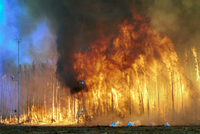-
Infrared camera to identify size of dangerous asteroids
The 1908 Tunguska event that flattened over 2,000 square kilometers in Russia was by some basic estimates caused by an asteroid only sixty meters in diameter; the impact of even a 1-kilometer-sized NEO would probably destroy an average state
-
-
Earthquake-proof bed patented
A Chinese inventor patented a design for an earthquake-proof bed; if your house collapses on top of you, the bed’s thick frame can support a roof — and the extra space inside its thick boards can store essential foodstuffs like canned goods and life sustaining water
-
-
DHS drill offers rare look at disaster preparedness
Anniston, Alabama, Center for Domestic Preparedness (CDP) offered another glimpse into disaster preparedness, this time focuses on disaster health care; a disaster drill observed by the media saw health care workers from throughout the United States acting out an explosion at a battery acid factory
-
-
New Florida museum is glass-covered hurricane-proof fortress

The new Salvador Dali Museum in St. Petersburg is designed to withstand category 5 hurricanes; the roof is 12-inch thick solid concrete; the walls are even thicker, at eighteen inches; the glass, which makes up big sections of the outside of the museum, can hold up to a category 3 hurricane; if that glass breaks, letting rain, wind, and debris into the facility, the art will still be safe: storm doors will shield the galleries on the third floor, and the vault, which is on the second floor (all of the art is placed on the second and third floors, above the 30-foot storm surge of a category 5 storm)
-
-
Hagerstown PD disappears from analog scanners
Those wishing to listen in on Hagerstown Police Department calls will have to update their technology: the “patch” to the old 800 MHz frequency, which allowed simulcasting of calls on the old analog frequencies, was taken down last week
-
-
New levee design, construction materials tested in Louisiana
Since Katrina, attention has been riveted on $14 billion worth of federal projects to rebuild the deficient hurricane levee system so it can better defend from surges out of lakes Borgne and Pontchartrain; the Army Corps of Engineers plans to start experimenting with a new construction method, which relies on a mix of lime and clay to build the test levee higher without widening the levee base; this method of raising existing river levees can be done faster than a standard raising and will not require buying additional land to expand the base; mixing lime and clay and water will not produce concrete, which has a measured strength of 3,000 pounds per square inch, or psi, the mixture will have a strength of 80 to 120 psi — substantially greater than the 3 to 5 psi of a compacted clay levee
-
-
Disaster response experts call for "red-helmet brigade"
Experts say that the world need to be better prepared to respond to natural disasters such as the Pakistan floods of the Haiti earthquake; they say that an organization such as the UN Office for the Coordination of Humanitarian Affairs should establish a special response unit to set up a computerized database that identifies all available assets routinely needed in an emergency — emergency personnel, medical personnel, water, non-perishable food stuffs, extraction machinery, temporary shelters, and field hospitals; some supplies could be held in locations around the world, ready to be dispatched as soon as disaster assessment experts working for a central command and control center arrive on the scene of a catastrophe
-
-
China, Pakistan floods; Haiti earthquake: not merely "natural" disasters
The recent disasters in Pakistan, China, and Haiti have done more than kill thousands and displace millions: they have raised questions about whether the modifier “natural” — as in “natural disaster” — is accurate in describing the sources and scope of the catastrophes; these and other recent disasters, in other words, raise questions about how much of the damage caused comes from the forces of nature and how much is the result of human activity; experts say that a major contributing factor to the scope of these disasters are development decisions which are too often controlled by wealthy and corrupt elites who have no interest in protecting people who have been marginalized by poverty
-
-
How to move forward on nationwide wireless emergency-response network
One of the lessons of 9/11 and Katrina was that there was a need for a nationwide wireless public safety and emergency-response network; trouble is, politics, arguments about spectrum allocation, business competition, and technology have all contributed to holding things up; one observer says that the way forward is for government to make a national emergency response network a wireless priority and devote dedicated, unencumbered spectrum to it
-
-
Wild fires in Russia may shower region with Chernobyl-era radioactive particles

Large forested areas in Bryansk were contaminated when the Chernobyl nuclear power plant’s Reactor No. 4 exploded during a pre-dawn test on 26 April 1986, spewing radioactive clouds over much of the western Soviet Union and northern Europe; radioactive particles settled into the soil, and environmentalists have warned that they could be thrown up into the air once again by wildfires and blown into other areas by the wind; the death rate in Moscow has doubled to 700 people a day
-
-
Cholera spreads in flood-ravaged Pakistan
With stagnant water throughout Pakistan, water-borne diseases such as gastroenteritis, malaria, and typhoid, now threaten the nation; there are reports of diarrhoea and cholera among the hundreds of thousands left homeless, and food and drinking water are in short supply
-
-
Good business: Developers make buildings more disaster-secure than building code requires
A Florida developer hopes to get more business by making his building hurricane-proof; with debris-resistant windows on all thirty-five of its stories, the developer says the building would withstand a Category 5 hurricane without significant damage; the extra hurricane proofing built into the Miami building shows that sometimes the private market can overtake the public sector when it comes to building design and safety standards; for example, in New York and Washington, D.C., some developers have put in anti-terrorism safeguards that exceed building codes
-
-
Keeping trains on track
Tel Aviv University helps develop early-warning hazard system for the world’s railways; researchers are collecting high-tech sensing data from satellites, airplanes, magnetic and soil sensors, and unmanned aircraft to devise a solution that will provide a reliable early-warning system for train operators; the solution will help keep trains on track during natural disasters and acts of terrorism
-
-
Dell warns of hardware trojan
Computer maker Dell is warning that some of its server motherboards have been delivered to customers carrying an unwanted extra: computer malware; it could be confirmation that the “hardware trojans” long posited by some security experts are indeed a real threat; the Pentagon is spending millions on research designed to ensure it can trust the microchips in critical systems, especially those made outside the United States
-
-
25,000 new asteroids -- 95 in near Earth orbit -- found by NASA's sky mapping
NASA’s newest space telescopes has spotted 25,000 never-before-seen asteroids in just six months; 95 of those are considered near Earth objects — which means, in the language of astronomy, that they are within thirty million miles of Earth; the telescope also sighted fifteen new comets and confirmed the existence of twenty brown dwarfs — stellar objects that are bigger than a planet but much smaller than a star; the full celestial catalog of what is out there will not be released to the public until next year after NASA has had time to process the images and flag false alarms
-
More headlines
The long view
Using Drone Swarms to Fight Forest Fires
Forest fires are becoming increasingly catastrophic across the world, accelerated by climate change. Researchers are using multiple swarms of drones to tackle natural disasters like forest fires.
How Climate Change Will Affect Conflict and U.S. Military Operations
By Doug Irving
“People talk about climate change as a threat multiplier,” said Karen Sudkamp, an associate director of the Infrastructure, Immigration, and Security Operations Program within the RAND Homeland Security Research Division. “But at what point do we need to start talking about the threat multiplier actually becoming a significant threat all its own?”
